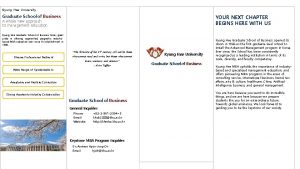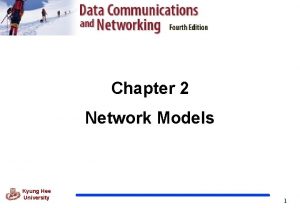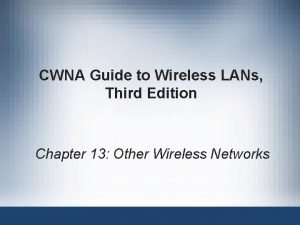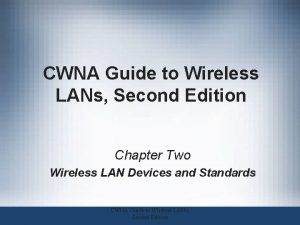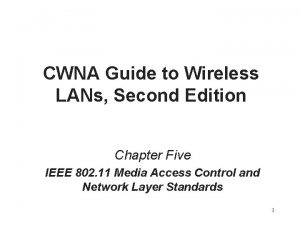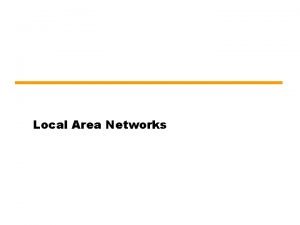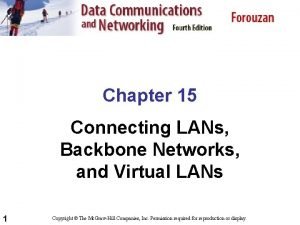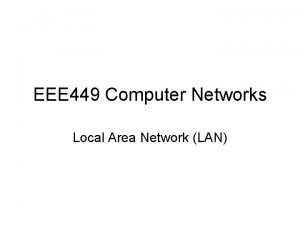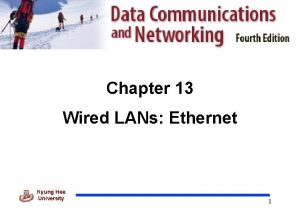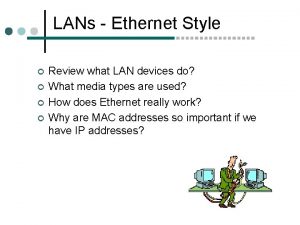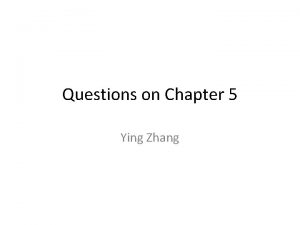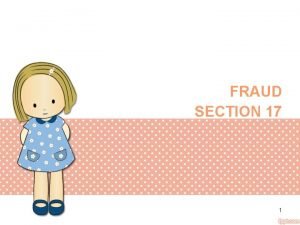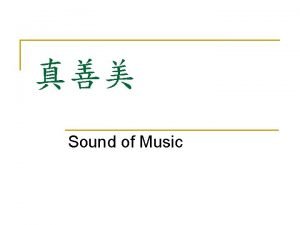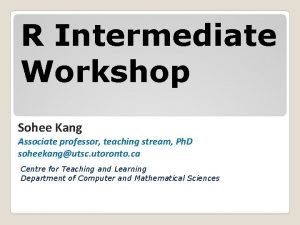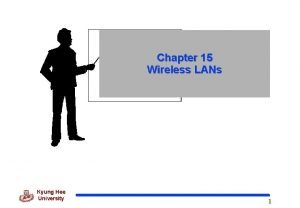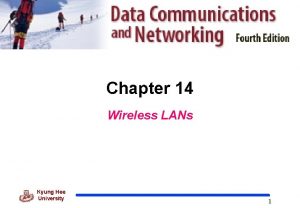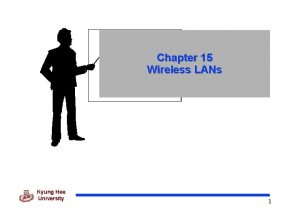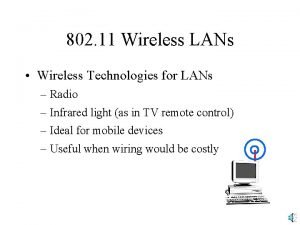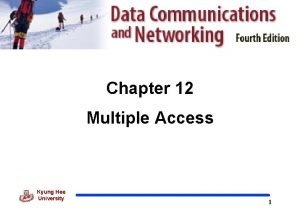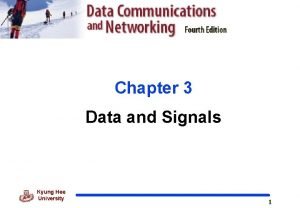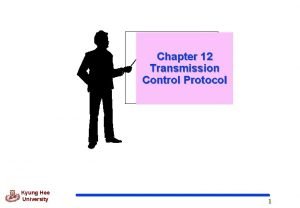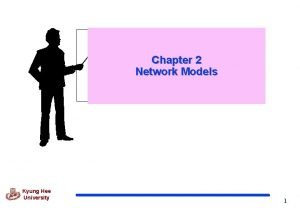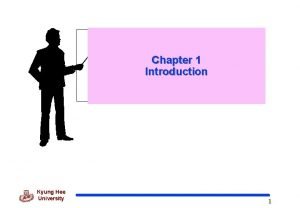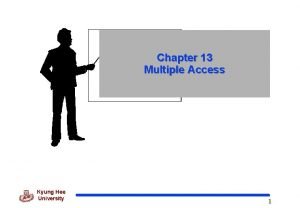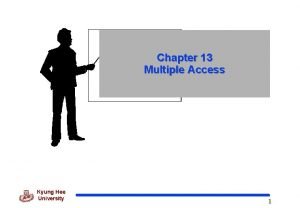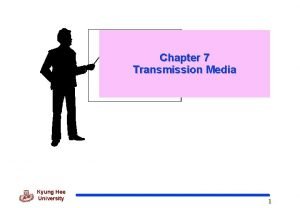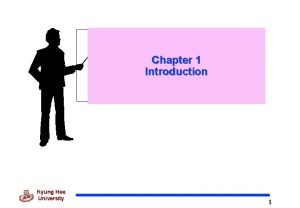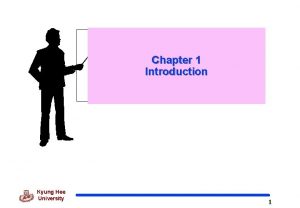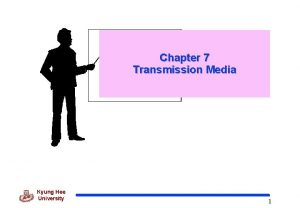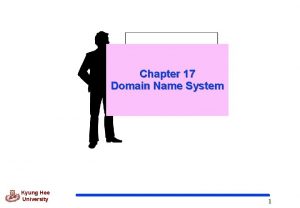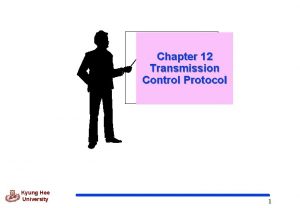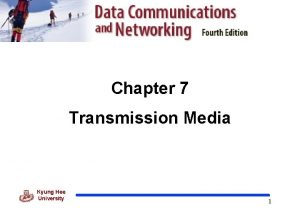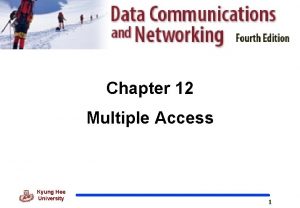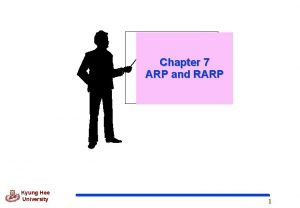Chapter 14 Wireless LANs Kyung Hee University 1
































- Slides: 32

Chapter 14 Wireless LANs Kyung Hee University 1

14 -1 IEEE 802. 11 IEEE has defined the specifications for a wireless LAN, called IEEE 802. 11, which covers the physical and data link layers. Topics discussed in this section: Architecture MAC Sublayer Physical Layer Kyung Hee University 2

IEEE 802 Standards Working Groups IEEE 802. 16 e : (Mobile) Broadband Wireless Access Wi. MAX, an acronym that stands for Worldwide Interoperability for Microwave Access(802. 16) Kyung Hee TAG (Technical Advisory Group) Wi. Fi (Wireless Fidelity) : 802. 11 University 3

15. 1 IEEE 802. 11 - Architecture q Basic Service Set (BSS) q Extended Service Set (ESS) Kyung Hee University 4

Basic Service Set • made up of stationary or mobile wireless stations, and possibly a central base station (access point) • BSS without an AP is stand-alone, cannot send data to other BSSs Kyung Hee University 5

Basic Service Set Note A BSS without an AP is called an ad hoc network; a BSS with an AP is called an infrastructure network. Kyung Hee University 6

ESS – Extended Service Set q Made up of two or more BSSs with APs – connected through a distribution system (usually a wired LAN) Kyung Hee University 7

Station Types q No-transition mobility – either stationary or moving only inside a BSS q BSS-transition mobility – can move from one BSS to another, confined to one ESS q ESS-transition mobility – can move from one ESS to another Kyung Hee University 8

MAC Sublayer Figure 14. 3 MAC layers in IEEE 802. 11 standard q 802. 11 defines the specs for the conversion of bits to a signal Kyung Hee University 9

Distribution Coordination Function q One of the two protocols defined by IEEE at the MAC sublayer is called the Distributed Coordination Function (DCF) v. DCF uses CSMA/CA as the access method. v. Wireless LANs cannot implement CSMA/CD for three reasons: 1. For collision detection a station must be able to send data and receive collision signals at the same time. This can mean costly stations and increased bandwidth requirements. 2. Collision may not be detected because of the hidden station problem. 3. The distance between stations can be great. Signal fading could prevent a station at one end from hearing a collision at the other end. Kyung Hee University 10

CSMA/CA Process flowchart Figure 14. 4 CSMA/CA flowchart Kyung Hee University 11

Frame Exchange Time Line Figure 14. 5 CSMA/CA and NAV DIFS – distributed interframe space, NAV – network allocation vector SIFS – short interframe space, RTS – request to send, CTS – clear to send * Collision only occurs during handshake period (RTS, CTS) Kyung Hee University 12

PCF q Point Coordination Function (PCF) v PCF is an optional access method that can be implemented in an infrastructure network. v. It is implemented on top of the DCF and is used mostly for timesensitive transmission. Kyung Hee University 13 Figure 14. 6 Example of repetition interval

Frame format FC : frame control D: the duration of the transmission that is used to set the value of NAV SC: Sequence Control – defining the sequence number of the frame to be used in flow control Kyung Hee University 14

Frame format Table 14. 1 Subfields in FC field Kyung Hee University 15

Management Frames q A wireless LAN in IEEE 802. 11 has 3 categories v Management Frame : 00 l Used for the initial communication between stations and access points. v Control Frame : 01 l Used for accessing the channel and acknowledging frames. v Data Frame : 10 l Used for carrying data and control information. Kyung Hee University 16

Control frames Kyung Hee University 17

Subtype values of subfields in control frames Table 14. 2 Values of subfields in control frames q type field : 01 Kyung Hee University 18

Addressing Mechanism q Table 14. 3 Addresses Kyung Hee University 19

Addressing mechanism: case 1 • To DS = 0 and From DS = 0 • Frame is not going to a distribution system • Frame is going from one station in a BSS to another • ACK sent to original sender Kyung Hee University 20

Addressing mechanism: case 2 q To DS = 0 and From DS = 1 q Frame is coming from a distribution system q Frame is coming from an AP and going to a station q ACK sent to AP Kyung Hee University 21

Addressing mechanism: case 3 • q To DS = 1 and From DS = 0 q Frame is going to a distribution system q Frame is coming from a station to an AP q ACK sent to original station q address 3 contains final destination of frame Kyung Hee University 22

Addressing mechanism: case 4 q To DS = 1 and From DS = 1 q Distribution system is wireless q Frame is coming from an AP going to another AP q ACK sent to original station Kyung Hee University 23

Hidden and Exposed Station Problems Figure 14. 10 Hidden station problem Kyung Hee University 24

Hidden and Exposed Station Problems Note The CTS frame in CSMA/CA handshake can prevent collision from a hidden station. Kyung Hee University 25

Hidden and Exposed Station Problems Figure 14. 11 Use of handshaking to prevent hidden station problem Kyung Hee University 26

Hidden and Exposed Station Problems Figure 14. 12 Exposed station problem Kyung Hee University 27

Hidden and Exposed Station Problems Figure 14. 13 Use of handshaking in exposed station problem Kyung Hee University 28

Physical Layer Table 14. 4 Physical layers Kyung Hee University 29

Physical Layer Figure 14. 14 Industrial, scientific, and medical (ISM) band Kyung Hee University 30

Summary q The IEEE 802. 11 standard for wireless LANs defined two services: basic service set (BSS) and extended service set (ESS). q The access method used in the distributed coordination function (DCF) MAC sublayer is CSMA/CA. q The access method used in the point coordination function (PCF) MAC sublayer is polling. q The network allocation vector (NAV) is a timer used for collision avoidance q The Mac layer frame has nine fields. The addressing mechanism can include up to four addresses. q Wireless LANs use management frames, control frames, and data frames. q IEEE 802. 11 defines several physical layers, with different data rates and modulating techniques. Kyung Hee University 31

Questions ! Kyung Hee University 32
 Kyung hee university mba
Kyung hee university mba Kyung hee university hospital at gangdong
Kyung hee university hospital at gangdong Html q
Html q Kyung hee model
Kyung hee model Cwna guide to wireless lans 3rd edition
Cwna guide to wireless lans 3rd edition Cwna guide to wireless lans
Cwna guide to wireless lans Cwna guide to wireless lans
Cwna guide to wireless lans Telecommunications, the internet, and wireless technology
Telecommunications, the internet, and wireless technology Captain kyung
Captain kyung High speed lans
High speed lans Difference between bus backbone and star backbone
Difference between bus backbone and star backbone Lans
Lans Lans
Lans Lans style
Lans style Internet technologies and applications
Internet technologies and applications Show that the maximum efficiency of pure aloha is 1/(2e)
Show that the maximum efficiency of pure aloha is 1/(2e) Adam lans
Adam lans Ethernet evolution through four generations
Ethernet evolution through four generations Out of programme pause hee
Out of programme pause hee Tan hee juan v teh boon keat (1934)
Tan hee juan v teh boon keat (1934) Horus.hee
Horus.hee Horus.hee
Horus.hee Fraud section 17
Fraud section 17 D
D Yhkim
Yhkim Hee chang trading co. ltd
Hee chang trading co. ltd Tan hee juan v the boon keat
Tan hee juan v the boon keat Hee joo lee
Hee joo lee Yodelay hee hoo sound of music
Yodelay hee hoo sound of music So-hee kang utsc
So-hee kang utsc Cheong hee kiat
Cheong hee kiat Horus hee
Horus hee Secondary 3 streaming
Secondary 3 streaming
